Introduction: Unraveling the Mystery of Castleman Disease

Castleman Disease (CD), though relatively rare, presents a unique set of symptoms that often go unnoticed or misdiagnosed due to their commonality with other health issues. It’s a disorder characterized by an abnormal growth of cells in the lymph nodes, and understanding its manifestation is crucial for prompt diagnosis and timely treatment.
The body, in its own intricate way, sends out distress signals when something’s amiss. And with CD, this comes in the form of a range of symptoms – from the palpable, like enlarged lymph nodes in certain regions, to the more elusive, such as unexplained bouts of fever. These symptoms may seem harmless or typical at first glance. However, their persistence, coupled with other signs, raises the alarm on a deeper underlying issue.
This article aims to be a beacon of knowledge in a sea of health information. By diving deep into the top 10 symptoms of CD, we hope to equip you with the necessary information to detect, understand, and seek intervention should you or a loved one exhibit these signs. Through this exploration, we’ll shed light on each symptom, drawing clear lines between what might be mistaken as a mere health hiccup and what demands more serious attention.
Being forearmed with this knowledge could be the difference between early intervention and prolonged suffering. Let’s delve into these symptoms, ensuring you’re well-prepared and informed for the journey ahead.
Symptom 1: Enlarged Lymph Nodes: The Body’s Silent Alarm

Enlarged lymph nodes often surface as the most familiar symptom associated with Castleman Disease (CD). These are usually found in the neck, underarm, and groin regions. On touch, they resemble soft, painless lumps, subtly hinting at something amiss internally.
Lymph nodes act as filtering stations, trapping viruses, bacteria, and other foreign substances, which are then destroyed by lymphocytes. Their enlargement indicates an increase in white blood cells due to inflammation, infection, or cancer. In CD, this enlargement is primarily attributed to an abnormal overproduction of cells.
Though these nodes are spread throughout the body, those in easily accessible regions like the neck or underarms are typically detected first. These growths can sometimes exert pressure on neighboring structures, leading to additional symptoms.
While many might initially dismiss this symptom, due to its painless nature, its persistence is a signal that the body’s immune system is reacting to something unusual. The nodes might swell, recede, and then swell again over time, following the disease’s unpredictable course.
In CD, the cause behind this enlargement is still a topic of research. Some scientists believe it’s due to an autoimmune reaction, where the body attacks its tissues, while others think it might be related to certain viral infections that trigger an immune response. (1)